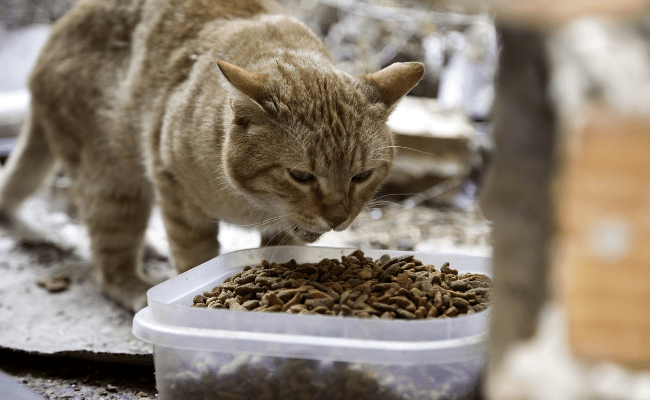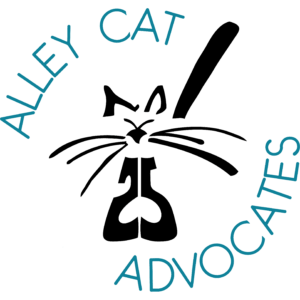
Are you feeding community cats? Here are some suggestions for making your feline feeding station the cat’s meow!
Station Location
- Feeding stations should have a low-profile and blend in with the immediate surroundings.
- Don’t locate the station in a high-traffic area as the cats won’t feel safe eating there.
- Placing the station out of sight of the general public draws less attention to where the cats are being fed, affording them greater protection.
Food and Feeding
- It is best to feed once a day, and at the same time each day. Daybreak and dusk usually are the two best times to feed, as cats are up and active then. But keep in mind: if you have predators around, such as coyotes, they too are active at daybreak and dusk. In that case, it’s best to consider feeding the cats during the day to minimize conflict.
- Canned food is closest to the cats’ natural diet, but canned food can be messy, attract more pests in the summer, and freeze in the winter. Dry food is more easily managed.
- You should have the food available for 30 minutes to an hour. That amount of time allows you to monitor who is eating (the cats will learn to come at that time and only that time to eat) and keeps wildlife away. After 30 minutes, pick up the remaining food.
- Dry food bowls should be kept free of debris such as leaves and dirt. Every couple of days, thoroughly clean bowls with soap and water before refilling them.
- To prevent ants from invading your food area fill a nine by 13-inch baking pan with an inch or so of water and place the food bowl inside it. This is known as the “moat” method.
- Make sure there is fresh water daily and that water bowls don’t become moldy. In cold weather you will need to keep the water from freezing.
- Keep the feeding station clean. Dirty feeding stations are a health risk for cats, an eyesore for the neighbors and are more likely to attract insects and wildlife.
Feeding Dishes
- Plastic and metal are the most widely used materials for feeding bowls. Heavy plastic bowls are versatile and easy to clean. Metal bowls can retain heat or cold better than plastic, staying warm or cool for longer periods of time.
- Select bowl colors that will blend in with the area where you’re feeding. A bright red bowl will draw unnecessary attention.
- Paper plates and paper bowls can be a cheap and easy option, but they aren’t water resistant. They also tend to blow around as soon as they are empty.
Monitor Your Colony
- After you feed, move away from the station and spend several minutes observing what happens. See who shows up, whether they are ear-tipped, and what kind of shape they are in.
- Keep a log of all of the cats in your colony. Jot down breeds, colors and descriptions, who has been fixed and when, etc.
- Monitor how much food the cats are eating on a daily basis. That provides an indication of how many cats you are feeding, and you will know what is “normal” for your colony.
- If the cats go through their food more quickly than normal, you may have a pregnant mom or some newcomers at the table.
- If your cats are eating less, make sure that everyone is accounted for and watch for health issues that might need medical attention.
Constructing a Feeding Station
- Your feeding station should be large enough to hold the bowls of food and at least one cat. Water bowls can be inside or outside the feeding station. The priority is to make sure the food stays dry and protected.
- A large rectangular storage bin, tipped on its side, makes an excellent station. The bin serves both as camouflage and as protection from the elements.
- Placing the bin on a couple of 2x4s or cement blocks keeps it off the damp or cold ground and away from any puddles.
- An empty cat carrier with the door taken off can also make a good feeding station. But be sure that it is waterproof!
- A piece of plywood propped against the fence in a “lean-to” position offers cover for food bowls, or for the entire station. It also provides camouflage.
- Place a piece of plywood on top of two cement blocks. Put the food bowls underneath the board and you have a cheap, but effective, feeding station.
Most Important of All: Feeding and Fixing!
- Providing food, water and shelter for outdoor cats is important, but it is also equally important to make sure all of the cats in the colony are spayed and neutered as quickly as possible.
- If not, your small colony will quadruple in size in a short period of time.
- Spaying and neutering the cats will not only stop the cycles of kittens, it will eliminate problematic behaviors such as howling, fighting and spraying.
If you’re feeding, you’ve got to be fixing! Call (502) 634-8777 to get started!
